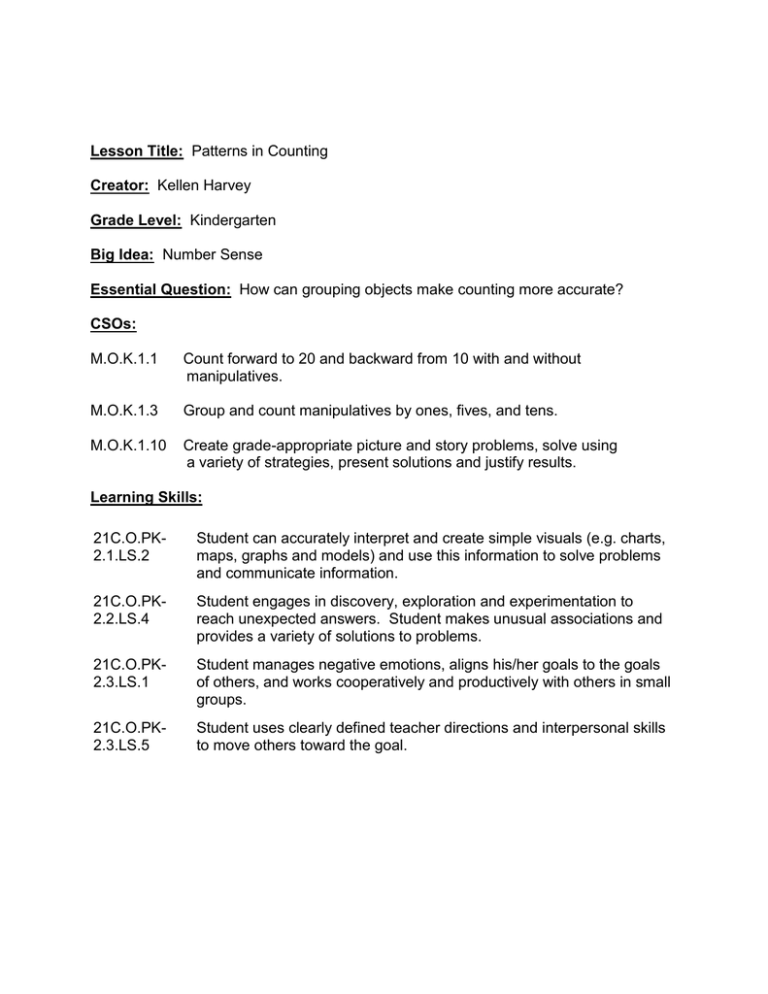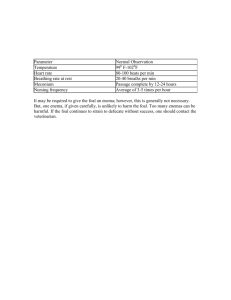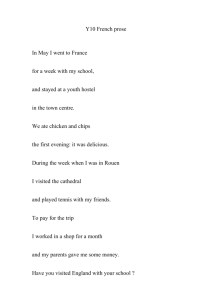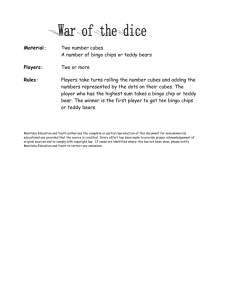Lesson Title: Creator: Grade Level:
advertisement

Lesson Title: Patterns in Counting Creator: Kellen Harvey Grade Level: Kindergarten Big Idea: Number Sense Essential Question: How can grouping objects make counting more accurate? CSOs: M.O.K.1.1 Count forward to 20 and backward from 10 with and without manipulatives. M.O.K.1.3 Group and count manipulatives by ones, fives, and tens. M.O.K.1.10 Create grade-appropriate picture and story problems, solve using a variety of strategies, present solutions and justify results. Learning Skills: 21C.O.PK2.1.LS.2 Student can accurately interpret and create simple visuals (e.g. charts, maps, graphs and models) and use this information to solve problems and communicate information. 21C.O.PK2.2.LS.4 Student engages in discovery, exploration and experimentation to reach unexpected answers. Student makes unusual associations and provides a variety of solutions to problems. 21C.O.PK2.3.LS.1 Student manages negative emotions, aligns his/her goals to the goals of others, and works cooperatively and productively with others in small groups. 21C.O.PK2.3.LS.5 Student uses clearly defined teacher directions and interpersonal skills to move others toward the goal. Launch/Introduction: I will begin the lesson by reading the story, Let’s Go Visiting, by Sue Williams. The story is about a child and his dog that go visiting different animals. At each stop, the animal/animals are eager to join in the adventure. They begin visiting one brown foal, then two red calves, three black kittens, four pink piglets, five green ducklings, and finally six yellow puppies. As I read the book for the first time, I will have students play the role of the animals in the story, using masks that I have previously made. Once the students recognize the pattern in the story, I will encourage them to predict how many animals will be visited next. Specialized Vocabulary Development: Predict Strategy Accurate Efficient Strategy Investigate/Explore: 1. After I finish reading the story, I will have the students go back to their seats and I will ask, “What was the first animal that the boy and his dog visited?” Then I will put a brown cube on the Elmo document reader to represent the foal. I will have baskets at the student tables where the students can build each animal themselves. I will tell them to get a brown cube to represent the foal. 2. Then I will ask, “What did they visit next? I will show them the next page to verify what animal was next. Then we will build the two red calves using two red unifix cubes. We will continue to build towers to represent each group of animals visited throughout the story until all of the animals are represented. 3. Then I will say, “Here is a problem for us to figure out. How many animals were visited all together?” I will allow them to work on figuring this out individually. I will review, “They visited one brown foal, two red calves, three black kittens, four pink piglets, five green ducklings, and six yellow puppies. After they answer I will ask them how they figured out their answers. 4. Then I will pair the students, giving each pair one of the cube sets of animals that were built during the story. I will say, “Think about all of the great ways that we have learned to count this year. I want you to work with a partner to see if you can figure out a different way we can group these cubes to count them more accurately?” Then I will allow them to work with their partner to build towers and count how many they have all together. For children who need scaffolding I will allow them to use a ten-frame for counting their cubes. I will circulate through the room, asking questions for the students to consider, “How many animals would you have if you added the calves and the piglets?” “Are there any combinations of animals that would make 5 if they were grouped together? 10?” :”Which animal group added to the yellow puppies would make 10 all together?” “How did you decide which animals to combine first?” Be sure to look for strategies being used, if children keep adding on each new group of animals and “counting on” or whether they make several sub combinations (like putting the foal and the piglets together to make 5 and then adding them to the ducklings to make 10) Summarize/Debrief: I will have each group to report out how many animals they counted all together. Then I will ask each group to show on the Elmo how they came to their conclusion. We will talk about that no matter which way we group them we will still get to twenty-one cubes. I will ask them why they chose to group the cubes the way that they did. I will end the discussion by asking why grouping objects to count them is important? Materials: Elmo, The story Let’s Go Visiting, by Sue Williams, baskets of unifix cubes (1 per table), and masks corresponding to the animals in the story. Duration: 1 hour Teacher Notes: Before the lesson make the masks that correspond to the story. I read the story and draw popsicle sticks to decide who gets to be each character in the story. This can even be a teachable moment as you choose the characters. (Check to see if the students pick up on the pattern. After you have chosen the two red claves, ask, “How many black kittens do you think I will need?” etc.) I think that it is important to work with your students in pairs because it will foster more talk time for the students. They will get to explore their ideas together and make choices to determine how they are going to find the total animals visited and will be able to justify their answers. Through experiences like these, students will come to an understanding that grouping objects makes counting more efficient. They will also realize that the total number of objects stays the same no matter how you group them.






